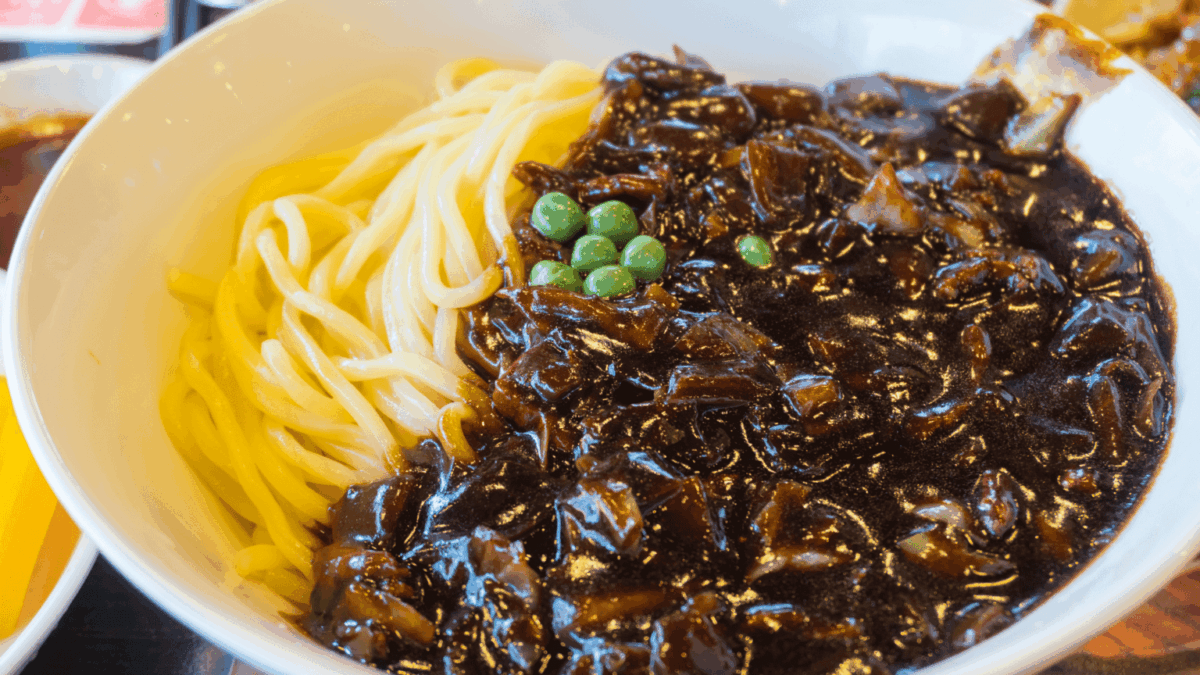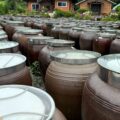Jjajangmyeon

Jajangmyeon is hard to miss in Korean cuisine. Its dark, almost black sauce makes the dish visually striking, and once you taste it, the unique flavors stay with you forever. It’s no surprise that Jajangmyeon is among the most popular Korean noodle dishes. Originally based on Chinese cuisine, it has been adapted over time to suit Korean tastes.
What is Jajangmyeon?
Jajangmyeon (자장면 or 짜장면) was first introduced to Korea in the early 20th century by Chinese immigrants and has since evolved into a distinctly Korean dish. It features thick wheat noodles topped with a thick, semi-sweet black bean paste sauce. The sauce is made from Chunjang (춘장), a salty black soybean paste originating from Northeast China, stir-fried with onions and minced pork or beef. The dish is commonly served with yellow pickled radish (단무지) to balance the richness.
The name Jajangmyeon comes from the Chinese zhájiàng (炸酱), meaning “fried sauce,” combined with myeon (noodles). The Korean pronunciation of “zhá” sounds like “jja,” which is why Koreans often call it Jjajangmyeon.
History
At the end of the 19th century, Chinese immigrants settled in Incheon, near Seoul, creating what is now Incheon Chinatown. The first Jajangmyeon is believed to have been served in 1905 at a restaurant called Gonghwachun. It was inspired by the Shandong Chinese dish Zhajiangmian but adapted by adding caramel to suit Korean palates.
After the Korean War in the 1950s, Jajangmyeon became widely popular, especially among merchants and dock workers due to its affordability and filling nature. It was traditionally eaten on special occasions like graduations and birthdays, but nowadays, it’s an everyday comfort food, with over 7 million bowls sold daily in Korea.
Chinese restaurants in local communities also pioneered food delivery services starting in the 1980s, helping spread Jajangmyeon’s popularity even further.
Ingredients and Preparation
The noodles used for Jajangmyeon are thick, slightly chewy, made from wheat flour, salt, baking soda, and water.
The key to Jajangmyeon’s signature sauce is Chunjang, also called Tianmian sauce, a thick black paste primarily made from fermented wheat flour with some soybean. It is stir-fried with pork or beef, onions, and sometimes seafood like shrimp or squid, plus soy sauce, oyster sauce, garlic, ginger, scallions, and vegetables like zucchini or cabbage.
The cooked noodles are served in a bowl, topped generously with the rich sauce. Common garnishes include thin cucumber slices, boiled egg, stir-fried bamboo shoots, or scallions.
Variations
¤ Ganjajang (간자장): A “dry” version of the sauce without stock, resulting in a thicker, chewier texture.
¤ Jaengbanjajang (쟁반자장): Stir-fried noodles with sauce served on a large plate instead of a bowl.
¤ Samseonjajang (삼선자장): Includes fresh seafood like squid, shrimp, and mussels for a fresher taste.
¤ Jajangbap (자장밥): Jajang sauce served over steamed rice instead of noodles.
¤ Jajang Tteokbokki: Rice cakes served with black bean sauce instead of the usual spicy red sauce.
¤ White Jajang (백자장): Made with Korean fermented soybean paste (doenjang) instead of black soybean paste; milder color but similar flavor.
¤ Instant Jajangmyeon: Available at supermarkets; includes brands like Paldo and Samyang, with spicy variations like Jjajang Buldakbokkeummyeon or Chapagetti.
Best Places to Try Jajangmyeon in Seoul
You can find Jajangmyeon in nearly every Chinese restaurant in Seoul, but some stand out:
¤ Donghui-ru (동회루) in Jung-gu: Known for handmade noodles and rich sauce.
¤ Gaehwa (개화) near the Chinese embassy: Over 50 years of authentic Korean-Chinese cuisine.
¤ Sinseonggak (신성각): Vegetable-rich sauce and silky noodles, in business since 1981.
¤ Incheon Chinatown: The birthplace of Jajangmyeon, with traditional and specialty versions like White Jajang.



